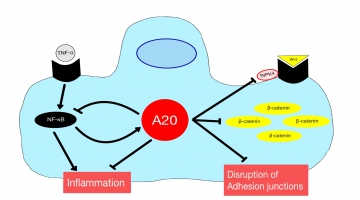Laurens Noack

Laurens Noack
Former MD Student
Medical Doctor Project 3
MD3: Role of A20 in lung barrier breakdown after trauma
|
|
Traumatic injuries as femur or pelvic fracture followed by hemorrhagic shock often lead to Remote Lung Injury (RLI), which forms the basis for the development of secondary complications such as Acute Respiratory Distress Syndrome (ARDS), contributing to the major causes of global mortality. However, the exact mechanisms of the RLI development still remain obscure. This project focuses on the disclosure of the pathophysiology, with special emphasis on the NF-kB and the Wnt signaling pathways and the impact of deubiquitinase A20 on both pathways. We hypothesize that the deubiquitinase A20 is downregulated after trauma, leading to an upregulation of Wnt signaling and the accumulation of ß-catenin by repealed inhibition of RIPK4. This leads to the disruption of adhesion junctions and ultimately to the breakdown of the lung cell barrier. Additionally, we claim that the effect of A20 on the NF-kB signaling pathway is downregulated as a negative feedback loop, leading to an increased inflammation within the lung tissue. Moreover, prior acute alcohol intoxication should have an immunomodulatory effect on NF-kB and the intratracheal administration of A20 should invert the effects described above. Therefore, both interventions could lead to a stabilization of the lung barrier, which would ultimately contribute to an improved outcome. In an in vivo model, mice receive a femur fracture in a mouse model followed by hemorrhagic shock. Additionally, ethanol is applied intragastrally and/or the A20 protein intratracheally prior trauma. Subsequently, the extent of lung damage is evaluated by measuring the total protein content in a bronchoalveolar lavage and the Lung Injury Score will be validated by lung histopathology. By using immunohistochemical stainings and quantitative protein analysis (ELISA, Western blot and flow cytometry) the extent of neutrophil and polymorphonuclear leukocyte invasion, local inflammatory changes (IL-6, CXCL1, CXCL5, TNF-a, NF-kB), lung damage (A20, RIPK4 and ß-catenin), apoptosis (M30 and active caspase-3) and pyroptosis (NLRP3) will be determined.
|
Photos: by UMMD, Melitta Schubert/Sarah Kossmann










